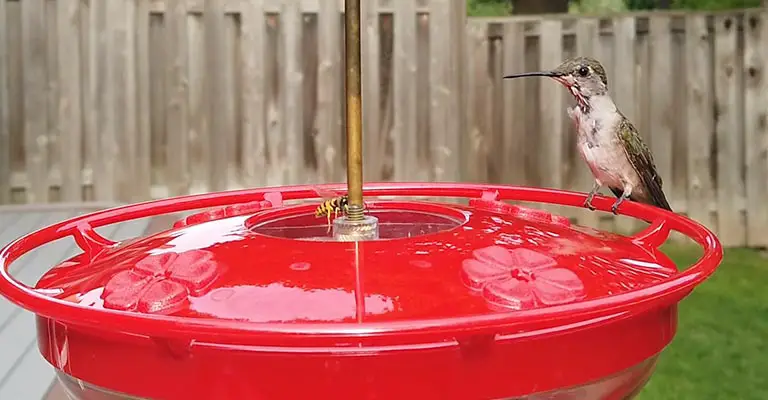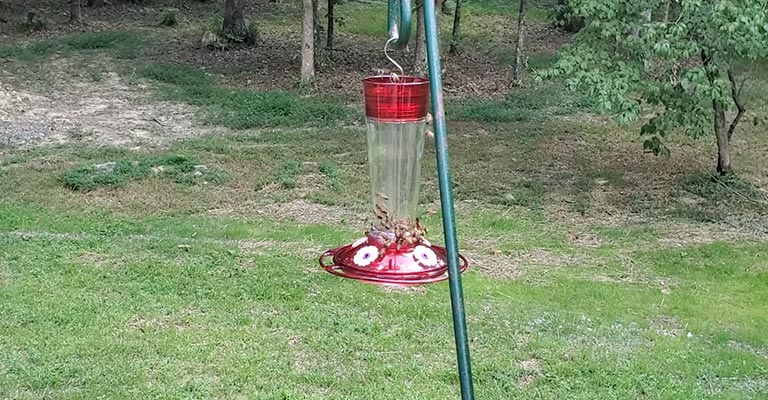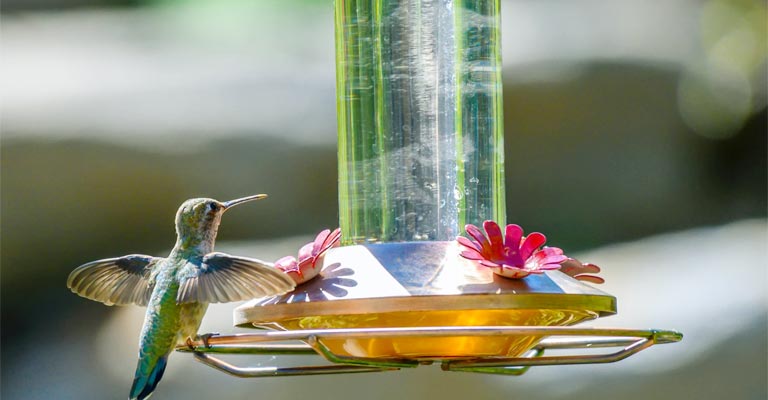Attracting hummingbirds to your garden with nectar-filled feeders is a joy for bird enthusiasts, but it can sometimes also attract another winged visitor: bees.
While bees play a crucial role in pollination and the ecosystem, it’s essential to strike a balance that ensures the nectar remains reserved for the hummingbirds.
To keep bees out of hummingbird feeders, a combination of effective techniques and solutions is required. This guide explores how to keep bees out of hummingbird feeders while ensuring the nectar remains accessible to these delightful, high-energy birds.
From bee guards and moats to feeder modifications and maintenance practices, there are strategies available to create a hummingbird-friendly environment without compromising on the well-being of our vital bee population.

How To Keep Bees Out Of Hummingbird Feeders?
Keeping bees out of hummingbird feeders can be a challenge, but there are effective and humane ways to deter them without harming the bees.
Here are some simple methods:
Use Bee-Proof Feeders
Invest in specially designed hummingbird feeders with bee guards or built-in barriers. These feeders have ports that are accessible to hummingbirds but are difficult for bees to access. Opting for these feeders from the start can prevent bee-related issues.
Adjust Feeder Design
Modify your existing feeder by adjusting the perches. Make them shorter, as bees need a landing space to access the nectar. By providing perches that are too short for bees but perfect for hummingbirds, you discourage bee activity.
Relocate the Feeder
Move the feeder to a shadier spot. Bees are more active in direct sunlight, so relocating the feeder to a shaded area can make it less attractive to them.
Use Bee Guards or Moats
Attach bee guards or moats above the feeder ports. Bee guards are small mesh screens that fit over the feeding holes, while moats are water-filled barriers that prevent bees from reaching the nectar. Both options create a barrier that bees find difficult to navigate.
Opt for Natural Deterrents
Apply natural deterrents like citronella or diluted peppermint oil to the feeder. Bees are repelled by these scents, making the feeder less appealing to them. Ensure the concentration is mild enough not to harm the hummingbirds.
Maintain Cleanliness
Regularly clean the feeder to remove any residue or drips. Spilled nectar or sticky residue can attract bees. Clean the feeder thoroughly during refills to avoid any lingering scent that might attract them.
Offer Bee-Friendly Plants
Plant bee-friendly flowers and herbs away from the hummingbird feeder. By providing an alternative food source, bees are more likely to be attracted to the natural nectar sources, leaving the hummingbird feeder alone.
By implementing these methods, you can create a bee-friendly environment for hummingbirds while discouraging bees from dominating the feeder, ensuring a pleasant experience for both the birds and the bees in your garden.
Why Are Bees Attracted To Hummingbird Feeders?

Bees are naturally attracted to hummingbird feeders due to several factors related to their foraging behavior and the composition of the nectar. Here are some reasons why bees are drawn to hummingbird feeders:
Sweet Nectar Odor
Hummingbird feeders contain a sugary solution that emits a sweet odor, which bees can detect from a distance. Their keen sense of smell guides them to potential food sources, including hummingbird feeders.
Color Attraction
Brightly colored feeders, especially those in shades of red or orange, are designed to attract hummingbirds. However, bees are also attracted to these vibrant colors. Bees perceive red hues and are naturally drawn to them, mistaking the feeder for a source of nectar.
Sugary Nectar Content
Hummingbird feeders are filled with a sugary solution similar to the nectar found in flowers. Bees are naturally inclined towards sweet substances, making the feeder’s nectar a desirable food source for them.
Accessible Ports
Some feeders have wide feeding ports that make it easy for bees to access the nectar. Bees are opportunistic feeders and will exploit any accessible food source, including hummingbird feeders with large openings.
Competition with Hummingbirds
Hummingbirds are territorial and often chase away other birds, including bees, from their feeding spots. However, when a feeder has multiple ports and a constant flow of bees, the hummingbirds may struggle to defend their territory effectively, allowing bees to dominate the feeding area.
Nectar Drips
Hummingbird feeders may drip or leak, causing nectar to pool around the feeding ports. Bees are attracted to these spills, exploiting the easy access to the sugary solution. Regular maintenance to prevent drips is essential to avoid attracting bees.
Scarcity of Natural Food Sources
In certain seasons or locations, natural nectar sources might be scarce. When flowers are less abundant, bees are more likely to explore alternative food sources, such as hummingbird feeders, to sustain their colonies.
Understanding these reasons can help bird enthusiasts take appropriate measures to deter bees and create a more enjoyable feeding experience for hummingbirds while ensuring bees have access to their natural food sources.
What Things Are Useful To Keep Bees Out Of Hummingbird Feeders?

Keeping bees out of hummingbird feeders is essential to ensure that the nectar is reserved for its intended visitors. Here are some useful methods:
Bee Guards
Bee guards are specifically designed accessories that fit over the feeding ports. These mesh or plastic covers create a barrier that prevents bees from accessing the nectar while allowing hummingbirds to feed easily.
Bee guards are highly effective and a popular choice among bird enthusiasts.
Moats or Water Barriers
Hanging a moat or water-filled barrier above the feeder can deter bees. Bees are reluctant to cross water, so suspending a container filled with water above the feeder forms a natural deterrent. However, regular refilling is necessary to maintain its effectiveness.
Opt for Flat, Basin-Style Feeders
Bees have a harder time accessing nectar in flat, basin-style feeders compared to those with deep reservoirs. Basin feeders have a shallower pool of nectar, making it more challenging for bees to reach.
This design encourages hummingbirds, which have long, specialized bills, to feed comfortably.
Modify Feeder Ports
Adjust the size of the feeding ports to be suitable for hummingbirds but too small for bees. Bees typically have broader bodies, so narrowing the openings can limit their access while allowing hummingbirds to feed unimpeded.
Use Saucer-style Feeders with Built-in Ant Moats
Saucer-style feeders often come with built-in ant moats, which can also deter bees. These moats are small reservoirs above the feeder filled with water, preventing both ants and bees from reaching the nectar.
Avoid Drip and Leakage
Regularly check for leaks and drips in the feeder. Bees are attracted to spilled nectar, so a leaky feeder can encourage their presence. Proper maintenance and cleaning can prevent spills, making the feeder less appealing to bees.
Move the Feeder to a Shaded Area
Bees are more active in direct sunlight, so relocating the feeder to a shaded spot can discourage their visits. Hummingbirds, on the other hand, are not deterred by shade and will continue to feed in a more comfortable environment.
By employing these methods, bird enthusiasts can create an exclusive feeding haven for hummingbirds while ensuring bees have access to their natural foraging areas, promoting a harmonious coexistence between these essential pollinators and our feathered friends.
FAQs
Why are bees attracted to hummingbird feeders?
Bees are attracted to hummingbird feeders primarily because of the sweet nectar they contain. The sugar content in the nectar is appealing to both hummingbirds and bees.
Additionally, the vibrant colors of some feeders, particularly shades of red and orange, are attractive to bees, as they perceive these hues as potential nectar sources.
Are bees harmful to hummingbirds?
Bees are generally not harmful to hummingbirds. They are simply competing for access to the nectar. While both hummingbirds and bees can coexist at feeders, excessive bee activity can deter hummingbirds from feeding.
It’s best to maintain a balance to ensure both species can enjoy the nectar without conflict.
What is the most effective way to keep bees out of hummingbird feeders?
Using bee guards or moats is among the most effective ways to deter bees from hummingbird feeders. Bee guards are mesh or plastic covers that fit over-feeding ports, while moats are water-filled barriers suspended above the feeder.
Both create barriers that bees find challenging to navigate, allowing hummingbirds to access the nectar easily.
How can I make my own bee guard for a hummingbird feeder?
Making a DIY bee guard is possible using materials like mesh or plastic. Cut the material to size and attach it securely over the feeder’s ports, ensuring it’s accessible to hummingbirds but difficult for bees to penetrate.
Always use bird-safe and non-toxic materials to avoid harming either birds or bees.
Is it possible to attract hummingbirds without attracting bees?
Yes, it’s possible to attract hummingbirds while deterring bees. Using feeders designed with bee guards, modifying feeder ports, or employing water-filled moats can help create an environment that is more inviting to hummingbirds and less appealing to bees.
Conclusion
Balancing the attraction of hummingbirds with the need to keep bees out of hummingbird feeders is a delicate task but one that can be achieved with patience and the right strategies.
The goal is not only to provide a reliable food source for these avian jewels but also to respect the important role that bees play in our ecosystems.
By implementing bee-deterring methods and ensuring a bee-friendly garden with plenty of native nectar sources, we can foster a harmonious coexistence between these two vital pollinators and create an environment where both can thrive.
Through these efforts, we can savor the sight of hummingbirds darting to the feeders while knowing that we are also supporting the well-being of our bee companions.